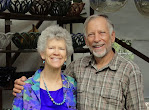On our first trip to Peru in 1996,
we stayed on Taquile for a week. We learned that the popular way to have electric power--lights and music--was to carry a lead-acid car battery the hour or so hike to the boat, charge it for a day in Puno, and return on the third day for, perhaps, three to four nights of power. We immediately recognized a perfect application for solar energy and brought the first photovoltaic panel in 1988.
Since then, the community has created micro-credit programs to pay for PV systems, individuals have managed to finance them themselves. And even, in 2002, a cultural dance group brought to Washington, D.C., got the Smithsonian to rush around and pay them in solar panels instead of money!
Sam and I used to bring panels, but now solar is available in several stores in local Puno and Juliaca as well as throughout Peru. Now we bring efficient LED lights and charge controllers, USB ports, voltmeters, inverters and various other accessories for the solar PV systems. We also buy equipment in Puno and then trade textiles for the equipment.
Last year, when our Colorado friends, Brad Burritt and Danielle LeCarre of Empowered Energy Systems, came to Taquile, they could see a need for further education, how PV systems here are getting large enough that it is time for some safety and more advanced expertise. So this year, thanks to community funding, advance training came to Taquile.
Asa Burritt speaks Spanish fluently. With Spanish-language teaching materials donated by Solar Energy International, he brilliantly taught a group of Taquileños advanced principles of photovoltaic system theory and design and application. Of course, he had help from his solar expert dad, Brad Burritt.
We held the class at our house, and at least a dozen people attended some or part of the course.
 |
| learning to test a solar panel |
 |
| more testing under charge and use |
Juanna was the only woman to attend the advanced course, but she slipped away and missed some important education. Taquile work is strongly gender specific, but we had hoped she would be one of our maestras. Maybe next time.
 |
| Meters for testing are important tools. |
In the end, four men, German, Silvano, Delfin, and Elias (not pictured) completed the course and received, not only certificates of recognition, but meters and reference books. Our final course activity was to make a full installation at the home of single mothers. Below is Maria, the happy recipient of a professionally installed solar electric system.
A primary goal of the course was to educate a few maestros, masters of solar technology, who would be the experts whom other Taquileños would call upon to solve their PV problems. These four were introduced in general maintenance classes held in the municipal building. Altogether, about 25 people attended the general class. We had hoped for more, but the word will spread.
After the workshops, Brad and Asa were invited to lavish lunches accompanied by requests to check out various systems. Below, Fredy's two panels are evaluated.








No comments:
Post a Comment